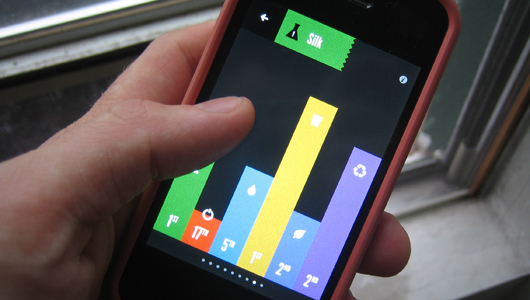Last month a new app quietly appeared on the Apple app store. Created by engineers and designers at Nike for apparel designers and driven by their cradle-to-gate Materials Sustainability Index (MSI),[1] The Making App represents a new development in sustainable design.[2] One that is designer-focused and user-friendly. Intended as an educational tool that works using comparisons between materials, version 1.0 has only 22 to choose from. These range from silk to grass and corn-fed leather to spandex, all materials currently used in today’s fashion industry.
The app looks wonderful and operates smoothly (some reviewers claim it crashes the iPhone 4). A designer will want to know (and will immediately see) how the materials stack up against each other within an impact category, but will have to go through several steps to reach an informative aggregate dashboard which shows how the material ranks across all impact categories and another panel showing its specific MSI totals.
Nike reminds the viewer of the Nike Materials Sustainability Index and in fact expects enlightened designers to visit the website [1] which houses it for further research. The MRI site actually shows a list of 46 materials, which allows toggling between impacts but lacks the organic and recycled category found in the app. The people at Nike have spent around 8 years researching their own materials library [1] and they have integrated about 75,000 entries into the Higgs Index, which is managed by the Sustainable Apparel Coalition (SAC)[3]. However, this is not reflected in this version of the app. The intention is that the user will be introduced to using comparative indexes through the app and will want to delve deeper.
At the very heart of this system are potential limitations. First, the MSI only covers cradle-to-gate data. In a full life cycle analysis, it may become apparent that certain materials with wonderful MSI scores may have terrible end-of-life data overriding any of the gains made in the early phases. It may even make certain material less suitable than materials with extremely low MSI rankings. For instance, some materials are almost certainly cradle-to-grave substances. On the other hand, some substances are endlessly recyclable and enjoy a high rate of reclamation. Other factors are chain-of-custody and transportation. Most designers understand that transportation has an impact on the sustainability of an item, but what people don’t necessarily understand are the processes performed in between the raw material processing and manufactured good. This is generally where things can get sticky and legal troubles can arise. An example being the claims around rayon viscose made from bamboo.[4]
While there is much to be improved, this is a wonderful project that creates a tangible way of connecting design ideas with real impact. Through awareness, traditional Life Cycle Analysis (LCA) information will become less daunting. Also, the people at Nike are open to user comments and criticisms in the quest to improve the system with each generation.[5]
As the lines of design continue to blur and designers from all disciplines continue to explore new methods and substrates with which to communicate, a tool like this would be valuable for any industry. Understandably, the task is daunting. But, what could the payoff be? In Gage’s Mitchell’s article, Where Graphic Design is Failing, he cites failures in education and a lax attitude in the industry.[6] Perhaps this is a way to “start making real change happen?”
Read more by Noble Cumming, MCAD MA in Sustainable Design alum, about Pushing Production to the Front of the Line.

